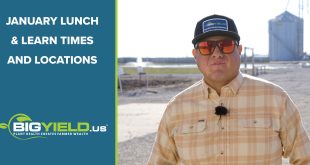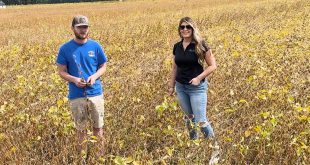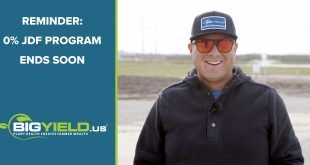Over the course of several videos, BigYield agronomist Shane Hall is going to cover “High Yields 101” – helpful information for our growers to attain better yields and higher profitability.
The first topic we want to cover is soil health. Healthy soil the is foundation of a successful crop, and there are several things you can be doing to improve your soil. Watch the video to hear Shane’s tips. If you have any questions, feel free to contact BigYield at any time.
Video Transcript
Hey everyone, Shane again here, certified crop advisor for BigYield and today I’d like to talk to you just a little bit about our soil health. A lot of the times soil health gets overlooked, I’ll tell you what the standard operation for most of us is. We need to know what we’re going to need for that season and so we go out to a 300 acre field, maybe smaller maybe larger, and we take one bag of soil and we send it off to the lab and think here’s all we need for the year, and we may even use those recommendations for the next three years. There’s nothing inherently wrong with that, but we can do better, that’s the key. We can do better.
In my head I have an illustration for this, I have the privilege of being, and have had for the last several years, of being a baseball coach on a competitive baseball team As the manager there are so many great things that happen, but one of the things that is hard for me to do every single year is cut kids when it comes to tryouts. You have these kids that come out and they try so hard but you can only keep the best kids, it’s a competitive baseball team, and so that’s the hard thing about it. Now what am I getting at, well if a kid comes and I say to him, hey son nice to meet you I’m very glad you came to the tryout today, I’d like to see you throw a ball. And so I hand the kid a baseball, he puts it into his hand and he throws it maybe a mile, maybe he doesn’t throw it very far at all. Either way after he’s done throwing the ball I say awesome job you’re on the team. What did I just do there? Well I didn’t take enough of a sample size, I need to know how the kid bats, need to know how he runs, can he catch, and what parts of the field can he catch the best, is he an infielder or is he an outfielder. So if I’m going to just allow kids on the team just based on one attribute, whether they can through or maybe it’s whether they can bat, or hey let me see how fast you are. That’s just not going to give me a good overall picture of the player that I’m inviting onto our competitive baseball team. Not only that but it would be unfair to a lot of the other kids. So that may be a crude illustration but that’s kind of what I think of when it comes to soil health. We take out one sample and it’s not really telling the full story of what’s going on in our fields, or what’s happening in the dirt in that particular field.
So what do we need to do? Well I’ve preached and I’ve preached, if you’ve been around me you know that I think that grid sampling is an incredibly important thing. Get your fields grid sampled and you don’t have to do two and a half acre grids, you don’t even have to do five acre grids, if you have a large enough field, 200 or 300 acres, do it in ten acres. At least you know exactly what you have in different parts of the field. You guys have been over your fields enough to know that each quadrant and section is different. This one’s got more water, this one’s lower, this one’s a little but higher. All those different factors factor in and that said, you’re going to have a variation in soil type, You’re going to have a variation in whether your soil is acidic or alkaline. So making sure you know what that is is going to playa big part in how your dollars are used and what I mean by that is we take that bag of soil, we send it off to the lab and it comes back and tells us exactly what we need to put on the season as far as our P and our K. That’s great that gives us an idea of what we need to put out there, but what happens when for example our soil pH is not right. What happens if our soil is too acidic and our plant is just unable to use the fertilizer that you put out there. What happens if our plants or if our soil is too alkaline and it’s just unable to reach and access the dollars that you put into your field. You know as well as I do that throwing that good money after bad is not going to help our bottom line. So it’s important, even just in the story of pH to know exactly what we’ve got going on whether we need to lime those fields or whether we don’t, but a lot of the times I see people do these grid samples and and I look and I see one particular part of the field has an acidic problem but the other ones are good.
So you may not have to use much lime and if that’s the case we’ll do a dance about that. So those are important things but there are other important factors when we get a soil test back. Not just the recommendations for P and K and all those different grids or in all those different sites but we’re also understanding tour CEC. The CEC is the cation exchange capacity and without going a lot into that, each of the ions, including the ions in our fertilizer are either positively or negatively charged, and if they don’t match up or if they’re not able to adhere to each other then we’re not going to have the success we need again for the plant to take up the nutrients. The plant is not going to respond to the soluble water and to the nutrients that are in the soil. So just in cation exchange we have to know what that is. So what if i have a cation exchange issue, well we can work on that, those are thighs we can work on and manage in that particular field whether it be by making sure that the pH is correct, but another factor that comes out in that soil report is organic matter. That’s super important, what our organic matter look like. Is there enough carbon in my field and in order for the natural process of nitrification to take place, is the soil able to break down in such a way that my plants again have a good bet that the roots have a good bed to grow in and reach out and go and get the nutrients that are there. Do the roots of the plant have a good bed to reach out and go and chase down the dollars that I’ve thrown into that field. Guys the biology of the soil is vastly important, the fungal activity, the bacterial activity that are in our soil, they’re important as well and so along with the organic matter, along with our cation exchange capacity comes this idea of living organisms that are within our soil. Our plants need those living organisms and in order to thrive and get those big yields that we are looking for.
I want you guys to think about these products that are here at BigYield, we have some biological products that can be put on foliar and I’ve seen those again increase the biological activity, increase the fungal activity, and give the plant that opportunity to take up those nutrients and to use them in vital ways, to increase the all the good things that are happening in that plant. Now one product that I really like is a really simple product is BigSweetYield and man this stuff can be used in your herbicide program because it can go on an dopent the stomates of not just the crops themselves but when this stuff hits the weeds they loves that sugar too so the herbicide gets in and it does a more effective job. Again the plants love it and because it’s increasing the fertility and increasing the vigor of the plant and just giving it an opportunity to grow. BigSweetYield is awesome, and I know you’ve probably seen a lot of testimonials on what it can for insects in the field. Now after a few years I believe if you use it regularly you’re going to see a drop in insects that are harmful to your crops like the bean leaf beetles and some of the harmful worms if you are using this product on a regular basis. So great products here and they have a lot of good options, we’ve got a lot of good options here at BigYield, things that can be tailored to your program, it can be entered into the things that you’re already doing to help increase yield and help to raise that bottom line.
So soil health, I don’t have to tell you guys it’s vastly important, but it’s important that we know exactly what we need to do with it, what’s the story in our field. So make sure that you’re again being proactive and making a plan and understanding what’s in your soil so that we can have an awesome 2021. Thank you for listening.
 BigYield High Yield Soybeans, High Yield Corn, and High Yield Wheat
BigYield High Yield Soybeans, High Yield Corn, and High Yield Wheat



